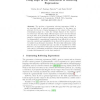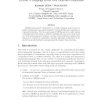100 search results - page 9 / 20 » Representing First-Order Logic Using Graphs |
COMCOM
2006
13 years 9 months ago
2006
In defending one's network against cyber attack, certain vulnerabilities may seem acceptable risks when considered in isolation. But an intruder can often infiltrate a seemin...
ICCAD
1999
IEEE
14 years 2 months ago
1999
IEEE
In this paper we present new methods for fast justification and propagation in the implication graph (IG) which is the core data structure of our SAT based implication engine. As ...
LACL
2011
Springer
13 years 20 days ago
2011
Springer
The problem of generating referring expressions (GRE) is an important task in natural language generation. In this paper, we advocate for the use of logical languages in the output...
MEMBRANE
2004
Springer
14 years 3 months ago
2004
Springer
LMNtal (pronounced “elemental”) is a simple language model based on graph rewriting that uses logical variables to represent links and membranes to represent hierarchies. The ...
SAC
2008
ACM
13 years 9 months ago
2008
ACM
se a new abstraction for pointer analysis that represents reads and writes to memory instead of traditional points-to relations. Compared to points-to graphs, our Assign-Fetch Gra...


